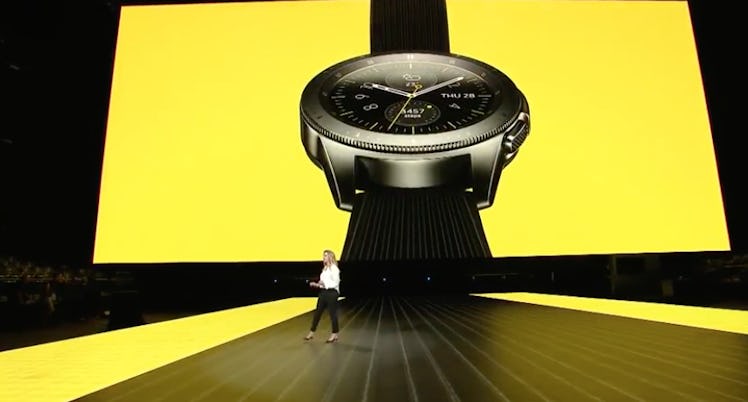Today is a huge day for wristwatch enthusiasts, because Samsung finally unveiled its first smart watch (!!!). The company announced the high tech accessory during its Galaxy Unpacked event, which began at 11 a.m. ET on Thursday, Aug. 9 in Brooklyn, New York. If you're live streaming the event on Samsung's website, you've probably seen the glorious debut of the new Galaxy Watch. It's sleek, stylish, and packed with all kinds of futuristic features. In fact, it's so dang awesome that you might have a hard time deciding between the Galaxy Watch versus the Apple Watch. If you're torn between which product you should add to your wardrobe, allow me to help.
Before you put your Apple Watch back in your closet and order Samsung's new Galaxy Watch, you should know about the main differences between the two. (By educating yourself, you'll know which choice is better for you.) For instance, one product might come in a color you'd prefer over the other, or there might be a certain feature you like that only comes on one of the watches. You don't have to play favorites, because the watch you choose is ultimately your decision. I'm just here to guide you through the process to make sure you know what each product has to offer.
Price
I don't know about you, but the first thing I take into consideration while deciding between two products is the price of each one. (Call me cheap, or call me savvy. IDC.)
Like most Apple products, the Apple Watch's price will vary. Depending on which model you get, the watch can cost between $329 and $1,399. However, if you're focusing on a standard 38-millimeter Apple Watch Series 3, you'll be looking at a $329 price tag.
On the other hand, Samsung's Galaxy Watch will come at a high cost. According to TechRadar, the it's predicted to cost more than other smart watches.
Design
There's an obvious difference between the Apple Watch and the Galaxy Watch when it comes to the design of each.
As you know, the Apple Watch is rectangular, while the Galaxy watch is circular. If you're into the classic, circular wristwatch, then Samsung's choice might be right for you.
The watches also differ when it comes to color. The Apple Watch Series 3 comes in seven colors, depending on which band you choose. The colors include pink, blue, gray, brown, white, silver, and black.
Samsung's Galaxy Watch comes in three colors, including rose gold, silver, and black. Before the phone was announced, some folks picked up the rose gold option because of an accidental leak on Samsung's website, per T3. As a rose gold enthusiast, I'm thrilled that this is an option.
Another difference between the Apple Watch and the Galaxy Watch is the size of the two. The Apple Watch Series 3 can come with a 38-millimeter band or a 42-millimeter band, while the Galaxy Watch comes with a 42-millimeter band or a 46-millimeter band.
Features
From one glance at the Apple Watch Series 3 section of Apple's website, it's easy to conclude that the watch is geared toward fitness-forward users. For instance, it comes with multiple workout features like smart coaching, achievement notifications, activity rings, activity sharing, and more. Of course, the Apple Watch comes with standard features like Siri, notifications, music streaming, and cellular capabilities.
The Galaxy Watch, on the other hand, has features that are just as impressive and fitness-related. Not only is the Galaxy Watch waterproof, but it also has health features such as a heart rate monitor, a breathing guide, a personal trainer, over 30 exercises to follow, and other similar features to help you stay fit. It even has stress management and yoga features to help you relax.
The battery life on the Galaxy Watch is super impressive, because it can last an entire day without being charged. That's super convenient for people who constantly forget to charge their phones (like me). For more information on the Galaxy Watch, keep an eye on Samsung's website.
Hopefully I helped you decipher between the Apple Watch and the Galaxy Watch a little better. After comparing the two products, it should be easier to decide which one you'd rather purchase.
